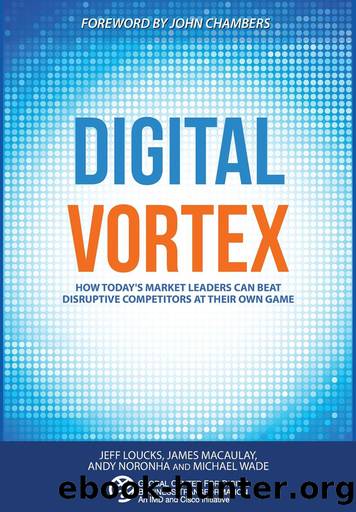Digital Vortex: How Today's Market Leaders Can Beat Disruptive Competitors at Their Own Game by Jeff Loucks James Macaulay Andy Noronha & Michael Wade

Author:Jeff Loucks, James Macaulay, Andy Noronha & Michael Wade
Language: eng
Format: epub
Publisher: DBT Center Press
Published: 2016-08-14T16:00:00+00:00
* * *
* This is supported by Cisco’s private-sector Digital Value at Stake research, which projects that people-centric connections will drive 64 percent of future value (2015-2024), while machine-to-machine connections will create 36 percent. Joel Barbier et al., “Where to Begin Your Journey to Digital Value in the Private Sector,” Cisco, January 2016, connectedfuturesmag.com/Research_Analysis/docs/Private-Sector-Digital-Value-at-Stake.pdf
* When discussing anonymous feedback mechanisms, it is important to distinguish between confidential feedback and truly anonymous feedback. Many companies provide confidential feedback mechanisms. Using confidentiality statements, these companies promise employees that responses will not be attributed to them, often by establishing a minimum threshold for data aggregation (e.g., aggregating responses of at least five employees). However, an employer could conceivably use various means, such as attribute data and network data, to identify employees. This is why simple confidentiality statements often do not convince employees to provide candid feedback. With truly anonymous feedback mechanisms, employers cannot attribute responses to individual employees because of the technical or process measures in place, such as automatic deletion of all personally identifiable information, or the use of a third-party platform to manage feedback, data storage, and analysis. Increasingly, employers will need to prove to employees that their feedback is truly anonymous, such as by explaining the technical or security mechanisms in place to guarantee anonymity.
* Named after the curious fish in the movie Finding Nemo.
* The term “knowledge worker” was coined by Peter Drucker in 1957 when he observed: “The most valuable asset of a 21st-century institution, whether business or nonbusiness, will be its knowledge workers and their productivity.” Over time, this segment of the workforce has grown, and it is estimated that in 2015, knowledge workers accounted for 44 percent of the U.S. workforce. Non-routine problem solving, the use of tacit knowledge, information seeking, collaboration, and other cognitive tasks characterize knowledge work. This does not mean that all knowledge workers sit behind a desk all day. In fact, many jobs that were once defined by physical labor have become much more aligned to knowledge work. For example, in some manufacturing industries, production workers on the factory floor often must be highly trained, and must use their experience and skills to address non-routine problems. See Peter Drucker, Management Challenges for the 21st Century, (Oxford: Butterworth-Heinemann, 1999), p. 116, and William G. Castellano, Practices for Engaging the 21st Century Workforce: Challenges of Talent Management in a Changing Workforce (Upper Saddle River, New Jersey: Financial Times/Prentice Hall, 2014), p. 22.
* According to research and consulting firm Trend Watching, “People – of all ages and in all markets – are constructing their own identities more freely than ever. As a result, consumption patterns are no longer defined by ‘traditional’ demographic segments such as age, gender, location, income, family status, and more.” “Post-Demographic Consumerism,” Trend Watching, accessed April 6, 2016, trendwatching.com/trends/post-demographic-consumerism/
* These mortgage practices are making a comeback as banks look to increase their loan portfolios. While our analysis in this book focuses on the private sector, we can see the potential for hyperawareness to help public sector organizations, such as regulatory agencies, detect and prevent fraud.
Download
This site does not store any files on its server. We only index and link to content provided by other sites. Please contact the content providers to delete copyright contents if any and email us, we'll remove relevant links or contents immediately.
Time Management Made Easy: How to Cultivate New Habits, Improve Productivity and Get Things Done by Joshua Strachan(2367)
The 7 Habits of Highly Effective People by Stephen R. Covey & Sean Covey(2098)
The Concise Laws of Human Nature by Robert Greene(1718)
Doesn't Hurt to Ask by Trey Gowdy(1555)
Primal Leadership by Daniel Goleman(1129)
Hook Point: How to Stand Out in a 3-Second World by Brendan Kane(1098)
HBR's 10 Must Reads 2021 by unknow(1045)
Don't Sweat the Small Stuff...and It's All Small Stuff by Richard Carlson(1016)
Amazon Unbound by Brad Stone(980)
100 Things Successful People Do by Nigel Cumberland(964)
HBR's 10 Must Reads 2021 by Harvard Business Review(956)
The Job Closer by Steve Dalton(939)
Master of One by Jordan Raynor(934)
Lives of the Stoics by Ryan Holiday & Stephen Hanselman(900)
Declutter Your Mind: A step by step guide to learn to control your thoughts, stop worrying, relieve anxiety and eliminate panic attacks and negative thinking by Mia Chandler(875)
The Power of 100! by Shaun King(845)
Conflicted by Ian Leslie(798)
Coders at Work: Reflections on the craft of programming by Peter Seibel(789)
The Book of Hope by Jane Goodall(744)
